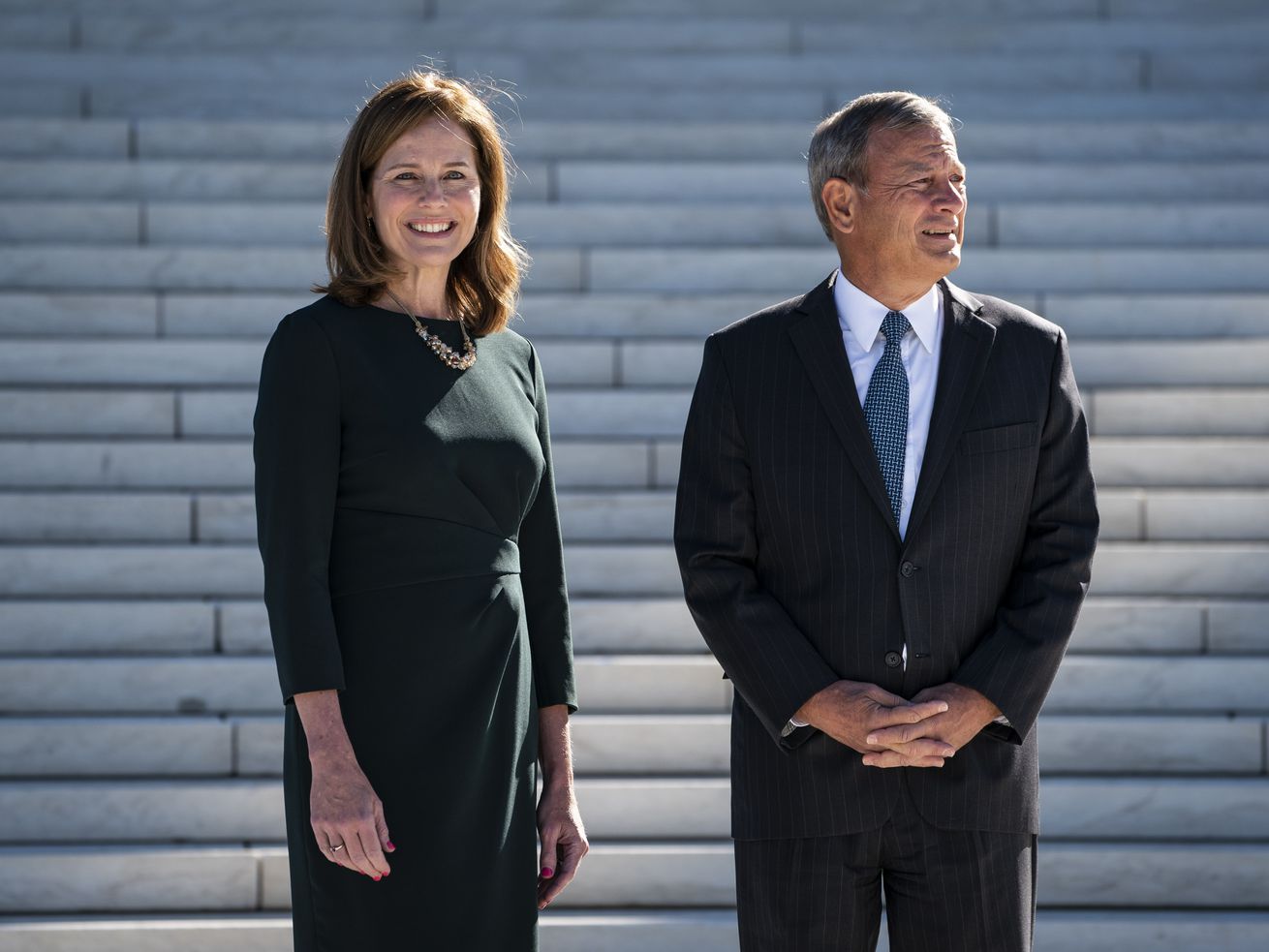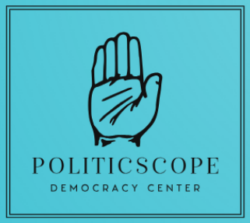
Justice Amy Coney Barrett is escorted out after an investiture ceremony by Chief Justice of the United States John Roberts at the Supreme Court on October 1, 2021, in Washington, DC. | Jabin Botsford/The Washington Post via Getty Images
Inside the Supreme Court argument asking if the justices should crown themselves kings and queens.
Four justices appeared absolutely determined, on Wednesday, to overrule one of the most consequential Supreme Court decisions in the Court’s entire history.
Chevron v. National Resources Defense Council (1984) is arguably as important to the development of federal administrative law — an often technical area of the law, but one that touches on literally every single aspect of American life — as Brown v. Board of Education (1954) was important to the development of the law of racial equality. Chevron is a foundational decision, which places strict limits on unelected federal judges’ ability to make policy decisions for the entire nation.
As Justice Ketanji Brown Jackson said during Wednesday’s arguments, Chevron forces judges to grapple with a very basic question: “When does the court decide that this is not my call?”
And yet, four members of the Supreme Court — Justices Clarence Thomas, Samuel Alito, Neil Gorsuch, and Brett Kavanaugh — spent much of Wednesday’s arguments in Loper Bright Enterprises v. Raimondo and Relentless v. Department of Commerce speaking of Chevron with the same contempt most judges reserve for cases like Plessy v. Ferguson (1896), the pro-segregation decision rejected by Brown.
The open question is whether the Court’s four most strident opponents of this foundational ruling can find a fifth vote.
None of the Court’s three Democratic appointees were open to the massive transfer of power to federal judges contemplated by the plaintiffs in these two cases. That leaves Chief Justice John Roberts and Justice Amy Coney Barrett as the two votes that remain uncertain. To prevail — and to keep Chevron alive — the Justice Department needed its arguments to persuade both Roberts and Barrett to stay their hands.
Barrett, of the two, appeared the most open to preserving Chevron. Among other things, she repeatedly expressed concerns about the disruptive consequences that would result from overruling one of the most widely cited Supreme Court decisions of the last century. As Justice Elena Kagan noted at one point, Chevron has been cited by 17,000 lower court decisions, and Barrett appeared troubled by the “flood of litigation” that would result if all of these decisions were called into question.
Roberts, meanwhile, spent much of Wednesday’s arguments downplaying the significance of Chevron. That said, the Chief did have a colloquy with Paul Clement, one of the lawyers arguing in favor of overruling Chevron, which suggests he may be looking for a way to hand Clement’s client a narrow victory without deciding if Chevron itself should fall.
So the bottom line is that, if you are a gambler, you should bet on Chevron being overruled. But there is an off chance that Roberts and Barrett will decide not to make one of the biggest power shifts to an unelected branch of government in American history.
Why is Chevron such a big deal?
Congress routinely passes laws that delegate policymaking authority to a federal agency.
The Clean Air Act, for example, requires certain power plants to use “the best system of emission reduction” that currently exists — then tasks the EPA with determining what the “best system” is at any given moment. The Affordable Care Act tasks the Department of Health and Human Services to come up with a list of preventive medical treatments and vaccines that health insurers must cover. Congress gave the Federal Communications Commission the power to determine whether “effective competition” exists between cable and other television providers in a given area — a determination that matters because the FCC has more power to regulate rates in areas without such competition.
One issue that inevitably comes up, when Congress delegates policymaking power in this way, is that it will sometimes be unclear whether a particular federal law gives a particular agency the power to take a specific action.
Take the Clean Air Act’s “best system” provision, for example. Suppose that two competing companies each invent a device that, they claim, is the best available technology to cut greenhouse emissions released by power plants. Both companies have an army of lobbyists, engineers, and scientists, who all argue that their employer’s invention is the “best system of emission reduction” and that the federal government should require power plants to install their tech. Each device is also incompatible with the rival device, so the government can require power plants to use either device, but not both.
Chevron recognized that, in a case like this, where it is unclear whether the law requires power plants to install one device or the other, someone has to have the final word on which device counts as the “best system” for reducing emissions. And Chevron held that the final word generally should rest with a federal agency (in this case, the EPA), and not with the courts.
As a unanimous Court explained in Chevron, there are two reasons why it is better to leave these kinds of policymaking decisions to an agency and not a panel of lawyers in black robes. One is that “judges are not experts” in the kind of difficult policy questions that come before federal agencies. Agencies, by contrast, are staffed by scientists, economists, physicians, and other experts who are more capable of evaluating difficult policy questions than a handful of people with law degrees.
The other rationale underlying Chevron is that federal agencies are inherently more democratic than federal courts. “While agencies are not directly accountable to the people,” the Court said in Chevron, the leaders of agencies are political appointees, and they answer to a president who is accountable to the voters. And so “it is entirely appropriate for this political branch of the Government to make such policy choices.”
Overruling Chevron, moreover, would transfer a simply astounding amount of power to the justices themselves. While there are many federal statutes delegating many policy decisions to agencies, that power is spread across 15 different Cabinet departments and an array of other independent agencies. So no particular agency or agency leader has authority over matters that do not fall within their area of expertise.
Meanwhile, while the president does have authority over all federal agencies, presidents must stand for election every four years, and can only serve two terms in office. So the president’s ability to make cross-cutting policy decisions across many agencies is temporary.
In a world without Chevron, by contrast, the Supreme Court will have the final word over all policy questions that previously were made by agencies. And, unlike the president, none of the justices are elected. And all of them serve for life.
The justices, in other words, could effectively appoint themselves kings and queens in the Loper Bright and Relentless cases. The fundamental question raised in both cases is whether nine unelected lawyers, all of whom have life tenure, should be placed in charge of virtually every policymaking decision made by the executive branch of government.
So what is the case for overruling Chevron?
Justice Kavanaugh, in particular, seemed so eager to give himself this power that he might as well have spent the argument shopping for gold crowns and drawing up an invitation list for his coronation.
Much of the Court’s right flank, meanwhile, fixated on an argument raised by Kavanaugh to justify this transfer of power. Essentially, Kavanaugh argued that courts interpret unclear or ambiguous statutes all the time. So why should they treat such a statute any differently just because a federal agency disagrees with their interpretation?
Suppose, for example, that instead of delegating policymaking authority to the EPA, the Clean Air Act had simply said that “every power plant must use the best system of emission reduction.” Absent such a delegation, courts would undoubtedly be called upon to interpret this ambiguous provision of law.
To a certain extent, Kavanaugh is correct that judges do interpret ambiguous laws all the time. And there’s little reason to doubt that, if Chevron were overruled, most of the justices would do their best to figure out what the “best system” is to reduce emissions once they were called upon to decide that matter.
But these are nine lawyers who do not specialize in chemistry, biology, engineering, or physics. If asked to determine which of two devices does a better job of reducing emissions, they could very likely get the answer wrong.
Moreover, as Justice Jackson noted, there are often “several reasonable meanings” of a particular statute, and choosing among equally plausible interpretations of a statute often requires value judgments that judges are ill-suited to make.
Suppose, for example, that EPA determines that one of the two competing devices will do a better job of reducing CO2 emissions, while the other will do a better job of reducing sulfur dioxide pollution. Both of these pollutants are harmful, but the tools of statutory interpretation used by judges offer little insight into whether it is more important to limit pollution from one chemical or the other. That requires the sort of value judgment that is best made by experts — and by political officials who can lose their jobs if they make bad decisions.
Of the Court’s six Republican appointees, Barrett appeared most likely to break with Kavanaugh’s attempt to crown himself King of All Federal Agencies. Like Jackson, she acknowledged that it is often difficult to draw a line between “law and policy.” And she repeatedly expressed concerns that the courts would be overwhelmed if all of the thousands of previous decisions where a judge deferred to a federal agency’s interpretation of a law had to be relitigated.
Roberts, meanwhile, floated a possible way to make these two cases go away.
Chevron, it should be emphasized, only requires courts to defer to a federal agency’s reading of the law when that law is ambiguous. But, as Clement argued at one point, there’s a decent argument that the particular statute at issue in this case can only be read one way.
Both Loper Bright and Relentless challenge the National Marine Fisheries Service’s decision that the commercial fishing industry must pay for some of the costs of placing observers on fishing vessels “for the purpose of collecting data necessary for the conservation and management of the fishery.” But the relevant federal law explicitly provides that fishing vessels should pay for these costs in some cases, and it is silent with respect to the actual fishing companies at issue in this case. That silence, Clement suggested, implies that his clients may not be required to pay these costs.
But if the statute is unambiguous, Roberts noted, then there’s no need for the court to “come to grips with the Chevron” issue. The Supreme Court could simply rule that these particular fishing companies do not need to pay for observers and defer until another day the question of whether Chevron should be overruled.
Yet, while that outcome is possible, it does not seem likely. As Jackson said at one point, anyone who cares about the separation of powers should be “worried about the courts becoming uberlegislatures” once these two cases are decided.
——————————————-
By: Ian Millhiser
Title: John Roberts and Amy Coney Barrett are unsure if they should be in charge of everything
Sourced From: www.vox.com/scotus/2024/1/17/24041626/supreme-court-john-roberts-amy-coney-barrett-chevron-loper-bright-relentless
Published Date: Wed, 17 Jan 2024 20:30:00 +0000
I'm a writer for lifestyle publications, and when I'm not crafting stories, you'll find me cherishing moments with my family, including my lovely daughter. My heart also belongs to my pets—Sushi, Snowy, Belle, and Pepper. Besides writing, I enjoy watching movies and exploring new places through travel.

